AFFILIATE MARKETING
How This 28-Year-Old Makes $8k+ Per Month From Affiliates, Ads, and Sponsors on Her Travel Site

Dani Ramos is an entrepreneur and adventurer at heart. She has launched several successful businesses, starting when she was just 11.
When she was in her early 20s, she backpacked around Europe, lived at a monastery school, crossed Africa, and hiked an active volcano.
It made perfect sense for her to document her adventures on a travel blog, and that’s how No Hurry to Get Home came to be.
Dani’s earning over $8k per month from her site, and she recently started a second site with a completely different strategy. She shares a ton of useful tips and actionable advice in this interview.
Keep reading to find out:
- What businesses Dani had before starting a blog
- Why she started to travel
- Where her income comes from
- What he second blog is about
- Her marketing strategies
- Her thoughts on SEO
- Her approach to keyword research and link building
- Her content creation process
- Her go-to resources and tools
- The biggest challenge she’s faced
- Her greatest accomplishment
- Her main mistake
- Her advice for other entrepreneurs
Meet Dani Ramos
Hi! My name is Dani. I’m from Mexico City but have lived all over the place (Monterrey, Florida, NYC, London, Thailand, Nairobi briefly, and Germany).
I spent most of my early 20s traveling and getting to see the world and doing all sorts of things.
That included working in Thailand, hiking an active volcano and seeing wild mountain gorillas in the Congo, living at a monastery school in Myanmar, traversing Africa using public transportation only (trust me, it’s an adventure!), backpacking in Europe, and lots more (seriously, the list is endless).
These days, I’ve “grown up” and have a perfectly “normal life.” I have an apartment, a dog, friends I actually get to see often and create strong connections with, and a closet with lots of space instead of a suitcase.
Long-term traveling is great and all, but it does come with sacrifice and I used to crave these things that I now take for granted when I was on the road.
I moved back to Mexico City because it’s my favorite place in the entire world and now travel more sporadically. I love all the comforts I have now, but I’m never afraid to say no to an adventure when the opportunity comes up!
Why She Created Her Website
I’ve loved writing ever since I can remember. When I was a teenager, I ran a cult film blog, a photography blog, and a fashion blog. They never really got any readers but it was something I really loved doing as a hobby.
Super long story short, it kind of all started when I had to withdraw from university because my family’s economy hit a slump and we couldn’t afford it temporarily. I realized I already had a ton of tangible skills and I could freelance.
Once I got a somewhat steady income, I bought a one-way flight to Madrid to backpack Europe and just sort of never looked back.
I became obsessed with traveling. I liked freelancing and I also eventually got a job in Thailand that gave me the opportunity to travel to several countries but I always knew I wanted more.
Having my own travel site had always been a dream of mine and one day, I just decided to buy my domain name while sitting at a terrace in a hostel in Rwanda. It was the best decision I ever made, and No Hurry to Get Home was born.
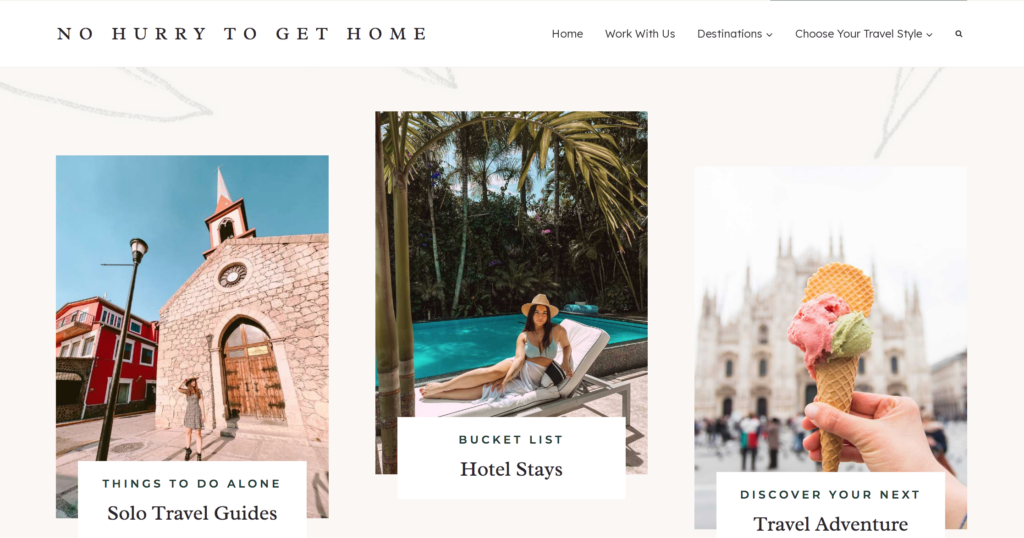
I only invested $13 to start. It was the best $13 I ever spent.
No Hurry To Get Home is actually a book by Emily Hahn. I first found her book “África To Me” at a library in a monastery school I spent a month living in Mandalay, Myanmar, and became obsessed with the author.
She basically traveled all over the world by herself back in the 1920s when that was really frowned upon and to date, she is still one of my biggest role models. She was not a famous author, so getting your hands on her books can be tricky.
My then-boyfriend managed to get me her book No Hurry To Get Home for my 23rd birthday and I just knew that had to be my site’s name.
Dani’s Other Entrepreneurial Experience
I’ve been the proud owner of several other businesses, too! I co-founded a shop (Nomadik Market) in Germany where I sold baskets, rugs, and all sorts of decor. We traveled a lot to Morocco to get products and I also brought a lot back from the places I visited while traveling for work. It did quite well but back then.
I was also freelancing, growing No Hurry To Get Home, and traveling so I didn’t have much time for it. It was actually a lot of fun and sometimes I fantasize about starting a similar concept here in Mexico City.
I also owned a content creation agency and a PLR online shop. I started these during the pandemic when my income practically disappeared and I had to keep myself afloat.
I ran those for over two years and I was making anywhere from $4000 to $5000 a month from them, but in late 2022, I decided to sell them because it was time to go back to working on my site full-time as well as start new projects I had in mind.
By this time, my blog had already recovered from the pandemic.
I was also a fashion photographer back in the day! I started photography when I was 11 and my work got published by a magazine in the UK when I was 13.
At 15, I started getting booked for photoshoots and even did a few campaigns in New York City, Mexico City, and Miami at 17-18 for local fashion brands and online boutique shops.
How Much She’s Earning
Currently, I’m making between $6500 to $7200 a month off of No Hurry To Get Home completely passively, plus anywhere from $1000 to $3000 extra with sponsored campaigns (be it press trips, product sponsorships, etc).
No Hurry To Get Home’s income comes from different streams (hotel bookings, tour affiliates, Mediavine ads, and others). Here’s a breakdown (it varies but it’s a pretty steady average):
- Hotel booking affiliates (Booking.com, Stay22, and Expedia): $4500 (average of $150 a day)
- Mediavine ads: $1000 – $1200 (My biggest goal is to at least double this before the end of the year).
- Other affiliates (tour bookings on Get Your Guide, travel insurance at Safety Wing, Amazon affiliates, etc): $1000 – $1500
- Sponsored content: $1000 – $3000
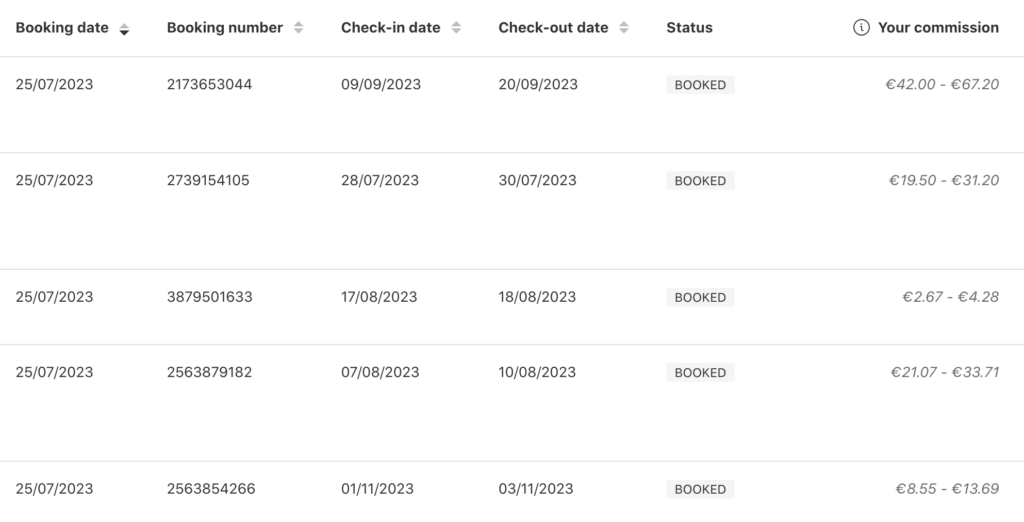
I also freelance from time to time by writing for publications and blogs to create credibility as an author and get that byline, but I don’t do it as often as I used to. This year, I’ve made about $4,000 off freelance writing and $2500 off a photography gig.
It took me four entire years to get to this income level, but that’s taking into account that a freaking pandemic completely destroyed the travel industry for over two years.
I would have gotten there much faster had that not happened, so if you’re new to the game, just know it doesn’t have to take that long under normal circumstances.
If you ask me, making your first passive $1000 is the hardest part, but once you reach that number, making $2000, $3000, $4000, and more gets increasingly easier.
When I reached my first thousand, I thought: If I can make $1000, I can make $10,000, and if I can make $10,000, I can make $100,000!
The sky’s the limit when you own a business and I know plenty of bloggers making over +$50,000 from their sites, so it’s not unrealistic and it’s very much a short-term goal of mine.
I also created The Guide CDMX. That’s a new project. So far, I’ve made affiliate money through campaigns, but at this point, I’ve invested more than I’ve made back. I have big, big, big plans for this project, so stay tuned!
That website and guide are completely in Spanish and targeted at Mexico City locals. The same SEO strategies apply, except the competition is so much lower compared to English sites!

You can easily rank for keywords with over 10,000 searches a month as competition is very low, so I don’t need to write humongous posts or get tons of backlinks to make it on SERPs.
With that said, Mediavine only accepts sites with a majority of US traffic, so ads may not be the way to go for me. Instead, I will focus on affiliate marketing (exact same strategies here) as well as memberships and social media campaigns.
I started it as a side thingy and a passion project to share the love I have for the restaurant scene in Mexico City some months back and it grew faster than I expected it to, so I was kind of at a loss as to what to even do with it.
I now have a laid-out business plan for it, so we can loop back and update this in 6 months or so. I don’t want to do the same thing I do on No Hurry To Get Home and would rather create a business in a more community-based way, but I’ll tell you all about it later!
How Much Traffic Her Site Is Getting
No Hurry To Get Home gets 60,000+ sessions per month.
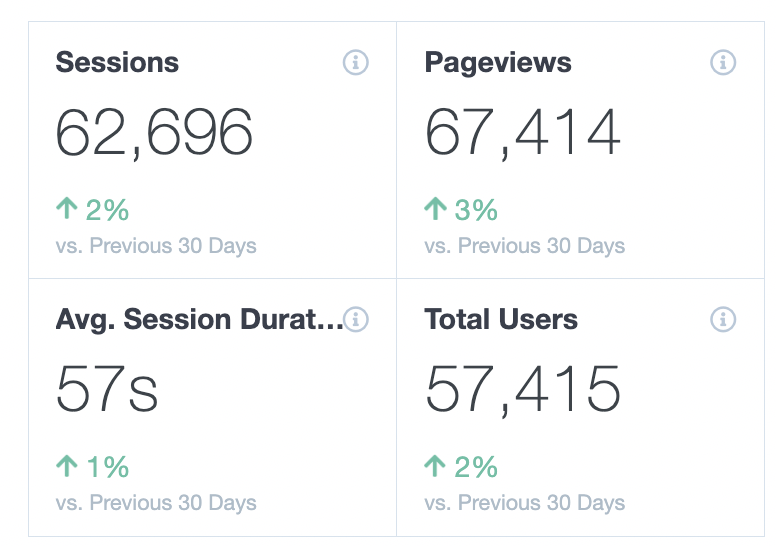
I used to think that making a full-time income from a site was only possible if you were getting hundreds of thousands of visitors, but if you target your audience right and understand user intent, you can make lots of money with much less than that.
Dani’s Main Marketing Strategy
I’m not sure I’d call it a “marketing strategy,” but one day I had an “aha” moment when it comes to user intent. Understanding what your traffic wants is key to making money from your site.
For example, if you want to make money off affiliate marketing through hotel bookings, it’s important to understand what keywords people who already have their flights to a destination booked and are ready to book a hotel are Googling.
To do this, you need to focus on long tail and super-specific keywords that someone who is ready to book a hotel may Google. Look for low-competition keywords, even if they don’t necessarily get tons of monthly searches.
For instance, it’s easier to rank for something like “best boutique hotels with a pool in X city” compared to “best hotels in X city.” Sure, the first keyword may not get as many searches, but the ones who do search for it most likely already have their credit cards in hand and are looking for something super specific, so it will be much easier to make a sale!
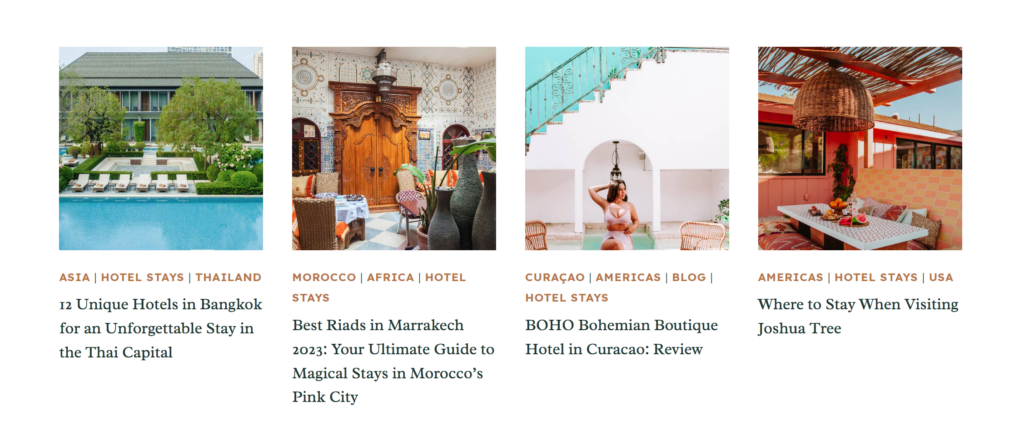
Another example would be, if you want to make money out of selling tours through Viator or Get Your Guide and earn an affiliate commission, you want to target users that are ready to book such tours.
Before, I would have thought using a keyword like “snorkeling in Cancun” would be great for that purpose, but it’s too broad as people could be Googling that out of simple curiosity or just be looking for a good destination for snorkeling and wanting to know if Cancun is a good option.
On the other hand, if you go for the keyword “snorkeling tours in Cancun,” you are already targeting people who most likely have their flights booked and are ready to book a tour! These users are what will make you money in affiliate bookings because they’re eager to purchase.
The Importance of SEO
SEO is super important! When I first started, I became a sort of Pinterest superstar and I basically managed to get into Mediavine with mostly Pinterest traffic. I eventually hit a slump and knew I needed to get over my fear of SEO in order to grow.
I’m not exactly sure why that is, but I used to think SEO was a really complicated science that I’d be too stupid to comprehend, but it’s actually pretty straightforward once you “get” it.”
I don’t have an exact strategy other than good keyword research, checking out competitors’ posts to see how you can create a better-value post (check which sites are ranking on the top three slots; you can always, always write a post that contains information they may have missed) and, of course, always going back to old content to update it to keep Google happy.
A game-changer for me was investing in the Stupid Simple SEO course.
By then, I already knew the basics of SEO through free online resources and was already seeing results, but taking the course gave me tons of extra knowledge as well as step-by-step guides.
I was making the first page on tons of posts just a few days after publishing them. I created my site in 2018 and got into Mediavine almost two years later, back when they only required 25k sessions.
It was almost entirely thanks to Pinterest traffic. Had I known how to do SEO properly, I’m sure I would have gotten into Mediavine much sooner.
Keyword Research
My keyword research strategy is pretty basic. I’ll go into KeySearch and type in a keyword I have in mind. Sometimes, that keyword will have a high search volume and low competition, but that’s not always the case.
If I don’t think I can rank for it, I’ll go and search KeySearch’s list of similar keywords until I find one with low competition (I try to aim for under a 34 difficulty score) and a decent search volume as well as find other secondary keywords I may also be able to rank for on the same article.
I then check my competitors and make sure they’re bloggers rather than bigger sites. Low competition, decent search volume, and at least 3 bloggers ranking on SERPs is the sweet spot for me.
Link Building
I don’t think it’s the most important thing (I barely made any effort to get backlinks for some of my highest-ranking posts), but it definitely matters.
I spend one hour tops working on link building for No Hurry To Get Home every week, and I see good results with just that. I get them through Facebook groups built specifically for travel sites looking to swap links, so I’ll go in every day and see if there’s anything fitting. I also participate in collaborations.
I’ve also guest posted a lot, but I found it takes up too much of my time and it hasn’t been worth it. I prefer to do short collaborations instead as it takes me under 10 minutes.
Dani’s Content Creation Strategy
The first thing I do is keyword research on KeySearch. After I have my keyword(s), I then begin editing or sourcing photos.
I’m a very visual person, so imagining how pretty my post will look like when it’s published gives me a huge hit of dopamine and keeps me inspired to finish it.
Afterward, I create a basic outline based on my templates and check out my competitors’ posts. If I can add a bit more value, my post is likely to outrank them on Google, so I will usually add a few more headings into the outline.
Then, I’ll add my photos to each section and get writing! I usually aim to make my posts at least 4,000 words long when it’s possible.

When that’s done, I add little elements like blocks recommending travel insurance (affiliate marketing), Pinterest pins, maps, and anything else that makes sense. I then get busy adding alt text and captions to each image and adding basic affiliate links like hotel recommendations for every budget and a few tours.
After it’s published, I will go onto related posts to add internal links, publish a pin on Pinterest, and see if I can do link swaps with other travel sites so that Google ranks my posts faster.
A few weeks later, if I’ve managed to rank the site high on Google and it’s starting to see traffic, I’ll then go and add more intentional affiliate content. This “strategy” really helped me make publishing easier because adding affiliate links is what takes up most of my time and energy.
It was really disheartening to spend 10+ hours working on a post only for it to not rank on Google and never see the light of day or barely make any money, so I now only add affiliate links when I know it’s doing well on Google. Plus, this helps me “update” the post and gives it a bit of an instant kick on the algorithm!
Her Email List
I have a pretty large email list that I should use more because I barely send out emails (oops!). It grew a lot when I started offering freebie printable packing lists on some of my posts.
I have about 10,000 subscribers and use Mailchimp. I do lose subscribers every time I do send out an email because I don’t think many of them remember subscribing to get a freebie and since I’m not active, they leave.
I need to improve my strategy here!
Progress With Her Second Site
The Guide CDMX is a relatively new project, but it grew so fast that I was getting invited to all of these kick-ass events, hotels, and high-end restaurants about a month in (good PR is huge in Mexico City and most have a budget to simply invite editors, etc to create good relations).
I think the “Dang! I’m really good at what I do” moment was when I was invited to a dinner hosted for the media. I was sitting at this table drinking champagne (get the reference?) with editors from huge magazines like Gentleman, Food & Wine, and Playboy.
At first, I felt very intimidated and was like, “My site is pretty new; why am I even here?”
Later that night, in conversation with the marketing agency that had organized the event, I was told they loved my work and really wanted to meet me and have me take part.
Claudia, the owner of the agency, told me that they were always all like “Oh yeah, Dani from The Guide this and that!” at the office.
It was a huge canon event for me because, after years of dealing with impostor syndrome, I realized I was actually good at what I do.
Ever since, I haven’t been afraid to own up to it and that has hugely reflected in my work, my income, and the way I carry myself.
Damn right, I’m good at what I do, damn right I’m an incredible writer/photographer/marketer/businesswoman, and damn right do I deserve to feel proud of my work and achievements!
How Much Time She Spends on Her Business
This really depends. I can be pretty obsessive and get lost in my work for weeks on end, so it’s not uncommon for me to work 10+ hours a day during some periods when I have a goal or simply feel like it.
I also have work days that feel like 24 hours, especially when I travel for campaigns!
I get flown very often to destinations in order to promote them, and even though it’s lots of fun, you’re always on schedule, dealing with traveling, creating content, etc. I think the toughest campaign I did was this year in Islas Marias, Mexico.
My schedule started at 5 am and ended at 11 pm for four days straight but it was a very interesting experience. It’s a brand new destination in Mexico because the island was a penal colony until 2019 and was only just opened to visitors this year!
That’s another joy of running a travel site. You get to see places and experience things nobody has before!
I love what I do and I actually have a ton of fun doing it, so it honestly rarely feels like work and I always feel excited to wake up and get started.
With that said, thanks to the fact that my income is mostly passive these days, I do have the freedom to take weeks or even months off if I feel like it.
I try not to do it because publishing content is something I truly enjoy, but having the option to say yes to going on a random day trip on a weekday or flying out to a new destination whenever I want to is the best part about it.
Making money is great, but the biggest asset running No Hurry To Get Home has given me is time freedom and there’s absolutely nothing in the world that is more valuable than that!
Her Favorite Resources
Mediavine On Air (Spotify) for tips on how to grow your site would be my top recommendation!
I don’t watch too many YouTube videos for education because I retain information better by reading, so I don’t have any to recommend, but definitely spend some time following/watching videos of people who already have the life/business you aspire to have.
I used to binge-watch channels of full-time travelers making money online back in the day and that’s what kept me inspired to keep working on my dreams. If they could do it, why couldn’t I?
Her Go-To Tools
The tools I use the most are:
Facebook groups: I love getting on Facebook groups to learn all about new strategies, stay on top of algorithm updates, and just generally get advice from more successful bloggers/site owners.
My favorite is the Mediavine group which is only open for Mediavine publishers, but there are plenty more out there. I usually check what’s new every morning while I drink my coffee.
KeySearch: This is my go-to tool for keyword research. I find it very easy to use compared to other tools and it’s pretty accurate.
Canva: I used to design everything (Pinterest pins, etc) on Photoshop and that took a ton of time. Canva helps me create the same amount of content in about 15% of the time. I also recently started to use it to resize images faster and it made a ton of difference.
Her Biggest Challenge
Definitely, the pandemic! I launched No Hurry To Get Home in 2018 and really started seeing success with it in 2019.
I was finally happy with how much I was earning, I was beginning to get booked for campaigns all over the world, and my future looked incredibly bright, and then BAM! The world shut down and I lost 90% of my income overnight.
At the same time, my long-term relationship ended and I moved back to Mexico City. It felt like I had to start everything from scratch—get creative and build a business that would provide the income I’d lost, start an entirely new life, and heal a broken heart.
It was really tough because my usual escape whenever I’m dealing with emotionally difficult situations is to either travel or focus on my site and both those routes were suddenly closed.
I did try starting a new site that focused on lifestyle but gave up very quickly because my energy was depleted. I felt like I had to navigate an entirely new way of life with zero tools and it was heart-wrenching.
I was swallowed by depression for over a year. I tried really hard to act like everything was fine and to get back on my feet because as an adult, you don’t really have an option but everything I did during that time was with what felt like a broken soul.
I thankfully learned a lot from the experience and gained a lot of confidence because that dark period of my life taught me how resilient I can be.
Her Most Important Accomplishment
Honestly? Making my young self proud!
I was a bit of a weird kid growing up. At 10, I randomly found a tutorial on how to create GIFs using a program called Paint Shop Pro.
One thing led to the other and suddenly, I started learning how to do graphic design and code my own websites.
I also became obsessed with photography at 11 and would spend every weekend taking photos of my friends. Blogging was also something I loved doing and from 11-18 even if nobody actually read them.
Another dream of mine? Traveling! I used to spend entire classes at school daydreaming about doing safaris in Africa, walking the streets of Europe, and seeing temples in Asia.

Put simply, my dreams at that age were to be a photographer, a graphic designer, a writer, and a traveler and now, I actually get to do all of that as a career out of something I built completely from scratch. How crazy/wonderful is that?!
I have also loved animals ever since I have memory, so I made sure to have a little “wildlife” section on No Hurry To Get Home and I’ve been able to work with companies like Big Game Parks in Swaziland (eSwatini).
What She Wishes She Knew When She Started
Don’t expect your business to magically grow. I used to think that blogging was all about writing and suddenly, a post or something would go viral and I’d become successful.
That definitely worked for a lot of OG bloggers but when I got into the game, that wasn’t really a thing anymore, at least not a common one.
I also wish I’d known that investing in education is key. I wasted way too much time learning how to grow my site using free resources.
I did learn a lot, of course, but plenty of that information was wrong or outdated. I began investing in courses about a year in and it made all the difference.
The courses that moved the needle for me were Stupid Simple SEO for SEO explained in an easy way (I really lost my fear of it after finishing the course), and for affiliate marketing, I recommend Making Sense of Affiliate Marketing.
Last but not least, I wish I would’ve started doing affiliate marketing sooner. I had no idea it was a thing back when I started and that almost every product out there can get you a commission.
About 9 months into my career, I went into existing posts and added hotel suggestions and travel product recommendations and out of what felt like nowhere, I made my first $500 from affiliates even though I was getting less than 10,000 readers a month back then.
Her Biggest Mistake
My main mistake was not charging what I was worth!
While I was growing No Hurry To Get Home, I was also freelancing as a VA and graphic designer in order to actually survive.
I look back and want to throw up at how much I sold myself short because I felt my work wasn’t “that good” or people wouldn’t want to hire me if I charged more than 15 bucks an hour.
Now that I actually get to hire people to do that work for me, I realize how good I was – I could’ve frankly charged a ton more and would have made the same money in less than half the time.
Her Advice for Other Entrepreneurs
I have a ton but something that’s been on my mind a lot lately is the importance of surrounding yourself with the right people.
As humans, we’re wired to mimic the behavior of the people we spend the most time with, so choose them carefully.
When I moved back to Mexico City, I didn’t have a lot of friends left there and I really craved deep connections so I sort of settled for any friendship that would come my way.

I was in a state of lack, so I allowed plenty of people in who didn’t align with my values or didn’t have my best interests at heart and that deeply affected my way of thinking, my priorities, my personality, my essence, and as a result, my business.
Recently, I made a decision to become more intentional with what and who I share my time and energy with.
My conversations have shifted from guys/other people to ideas/things we want to achieve/travel/etc and that has made a world of difference. I feel incredibly inspired every day to achieve my goals and generally happier even if my circle becomes smaller.
Moreover, know that you’ll have to sacrifice things like outings/parties/momentary pleasures, at least for a while.
A lot of people call me “lucky” but they definitely don’t see that I never partied during my early twenties and spent lots of late Friday nights and weekends working while everyone was out having fun.
Also, if it’s possible, get yourself an accountability buddy! I have a friend who also has a travel site and every morning, we text each other what’s on our to-do list and the things we plan on working on that day and we each get to work on our own tasks.
This makes it easier for me not to slack, because sometimes when you’re an entrepreneur, you kind of have the freedom to take a day off if you’re feeling under the weather. Having an accountability buddy really helps you stay on top of things.
AFFILIATE MARKETING
Gear up for Summer Camping with $22 Off This Power Bank Flashlight

Disclosure: Our goal is to feature products and services that we think you’ll find interesting and useful. If you purchase them, Entrepreneur may get a small share of the revenue from the sale from our commerce partners.
Summer is almost here and spending time outdoors is known to ease stress and anxiety and enhance cognition. If you plan on spending some time in the great outdoors with clients, employees, or family, you should make sure you have the right tools. We’re not talking about tents and camping stoves; we’re talking about emergency tools, like this Outdoor Flashlight with Flame Simulator & 2400mAh Power Bank.
This light can keep your devices powered up, which keeps you reachable and able to handle any potential work emergencies. It also has a cool LED screen that simulates a campfire to add to the fun.
Most importantly, this outdoor flashlight provides ultra-bright LED lighting to give you visibility at night. The fireplace simulator mode also adds some light, with an adjustable flame setting that helps set the ambiance and provides some additional visibility while mimicking a real fire.
The durable flashlight is made with COB technology to provide a bright and even light output and is rechargeable via a USB-C charger or via solar panels during the day. It can last for up to 24 hours on a single charge and is built to withstand all weather conditions.
And perhaps best of all, it features a compact, portable design that makes it easy to pack in your car or carry in your backpack. Whether you’re going fully off the grid or just spending a night in the backyard with the family, it will come in handy.
Gear up for summer entertaining and fun.
Right now, you can get this Outdoor Flashlight with Flame Simulator and 2400mAh Power Bank for just $39.99, a 36% savings from the original price of $62.
StackSocial prices subject to change.
AFFILIATE MARKETING
How to Know When to Hire Your First Employee

Opinions expressed by Entrepreneur contributors are their own.
At some point as an entrepreneur, you’ll face a challenging decision: When is it time to hire your first employee? After incubating the idea of your startup. then deploying your resources and making it all happen, at some point you may realize it’s time to bring someone else in to help you achieve your vision and grow the business. It’s exciting, but at the same time, can be daunting. What if the new hire doesn’t work out? What if you hire too many people or too few?
Entrepreneurs are inherently self-starters and ambitious, and shifting responsibilities to new workers can be difficult – but it’s a necessary step for growth. A company needs support to grow and thrive. You can’t do it all on your own, which makes hiring employees — especially the early ones — a crucial step toward entrepreneurial success. Before you do anything, though, ask yourself: Is this the right time to hire?
Knowing when you shouldn’t hire
Before addressing best practices for hiring, it’s vital to recognize common pitfalls entrepreneurs face when starting to grow their workforce – that starts with knowing when not to hire. Similar to making big life decisions, you should avoid hiring employees out of anxiety or uncertainty. Your choices should be deliberate and strategic. Take a step back and reconsider hiring employees if you find yourself in the following situations:
You’re desperate
If you have more work than you can humanly handle and you just need to get another body behind a desk, it’s tempting to find someone right away. However, a hasty decision born of desperation is rarely a good one. Take the time to find the right person for the job.
You don’t have specific responsibilities for an employee
Unless you have a defined set of tasks and expectations for your new hire, do them a favor and don’t hire anyone. A new hire at this stage will rightfully be confused and ineffective. You may need help, but if you don’t know exactly what that help will look like, consider hiring a coach instead of an employee.
You’ll take anyone
If you’re lucky, the first applicant will be an absolute rockstar who can bring your business to the next level – but that’s not the norm. You’ll learn a lot about yourself, the applicant market and your own position by interviewing more candidates. The variety of skill sets on display can also hone your focus for what your future employee will do.
Hiring your first employee
Hire someone too early and you could have cash flow problems, a worker who has nothing to do and the added stress of management. Hire too late, and you could be inundated with work you can’t accomplish, which could lead to missing deadlines and losing out on business.
Finding the right moment to hire, therefore, can make the difference between a failed enterprise and a successful business. But how do you know when the time is right? The following tips can make this process a little less painful and provide options for making that first hire:
Start with a cofounder
If you’re a solopreneur looking to make that next step, bringing on an employee can be intimidating. Instead, hire a cofounder, or at least someone who thinks like one.When making that first hire, look for someone with cofounder potential and traits, such as complementary skills, similar values and vision, teachability, passion, emotional intelligence, flexibility and honesty. Your first employee will hopefully be one of your longest lasting and most knowledgeable.
Ask yourself: Will these tasks generate money?
It’s been said that the only two purposes of an employee are to: 1) make money for the business, or 2) save money for the business. If you’re confident a new hire will do at least one of those two things, go for it. In the early stage of a company, making money is more important than saving it. Typically, these early roles involve creating products (designers, developers, etc.), marketing products (growth hackers, content marketers, etc.) and supporting products (customer support, help desk, etc.).
Know your desired skill set
Before you search for an employee, you need to know what kind of candidate you’re looking for. It’s not enough to simply know that you “need some help” or “need a developer.” Get specific: You don’t want just a “developer.” You want a Javascript developer with GitHub experience able to create machine learning algorithms with educational applications, for example. The clearer your set of responsibilities are, the more effectively you can hire someone to fulfill those duties r.
Delay the decision by hiring a contractor
You may still be undecided over whether or not it’s time to hire. Don’t sweat it. Instead, test it. Try hiring a contractor with the same set of parameters you’re looking for in a full-time employee. The introductory hassle of onboarding a contractor is relatively low compared to that of hiring an employee. You can create a contract for one month, six months or a year. If it works out, you can transition this person into an official hire or look for a full-time employee.
The differences between hiring freelancers, contractors and employees
The major differences between freelancers, contractors and employees has to do with their relationship with the business owner. Freelancers and contractors are self-employed individuals, while employees are hired by the company. Freelancers and contractors typically set their schedules based on the needs of their clients and work out a payment schedule (typically upon completion of a job).
Employees, on the other hand, work the schedule established by the company and receive a regular paycheck on a schedule set by the company. As a business owner, you’re responsible for tax reporting on your payroll employees. But since freelancers and independent contractors are considered self-employed, they are responsible for reporting their taxes.
So what’s the best decision for your company? It depends on your needs, your resources and your ambitions.
When should you hire a freelancer?
Some people use the terms “freelancer” and “contractor” interchangeably, but there is a difference in the type of professional you are hiring. Freelancers usually work on smaller, short-term projects, while contractors work on larger, more long-term projects.
Freelancers are great options for specific support — for example, bringing on a digital marketer to get your social media up and running. If you’re not financially ready to bring on full-time employees for whom you have to provide employee benefits, a freelance relationship may be a better setup.
When should you hire a contractor?
Contractors generally come with a team of expert professionals who can get you the help you need, whatever it may be. They can handle specialized projects, such as IT, remodels, design and consulting. As your business grows, financial consultants can keep you on track with your financial goals. If you need highly specialized work that requires a team, contracting a company will ensure the job gets done right.
When should you hire an employee?
Not every company needs a large number of employees, but if you hold frequent meetings, rent an office space or interact with customers, you’ll want reliable employees to help support the business. Remember, just because someone looks good on paper doesn’t mean they’re a good fit for your business. They must fit into your company’s culture. Consider bringing on full-time staff if they can make you more money or improve the customer experience.
Why hiring globally might be your best move
The growing popularity of remote work has meant dramatic growth in the pool of available talent. Don’t limit yourself to just domestic workers, though. By hiring workers outside your country, you can save money, increase efficiency and still provide customers with superior service. Consider the following benefits to hiring globally.
A wider talent pool
As unemployment levels drop, the demand for skilled workers rises — especially for roles in software engineering or data science. By looking past your own borders, you can grow your pool of potential employees and have access to a wider swath of workers. For example, Poland, Slovakia and India are renowned for their pool of highly qualified tech professionals available to work remotely for international companies. Tap into this talent network to find the right fit for your company.
Cost efficiencies
Hiring overseas means access to employees who live somewhere with a much lower cost of living, which generally means lower salary expectations. The requirements for compulsory employer contributions and payroll taxes that increase business costs also vary by country. For example, countries like Germany and Japan generally require that employers deduct a certain amount of the employee’s pay for health insurance. But Australia and New Zealand, with public healthcare systems, do not require such employer insurance contributions.
Access to resilient international markets
If you run a growing, ambitious business, you may be eyeing overseas expansion. One of the biggest factors in your success will be having employees familiar with that market. You have a few options for growing an international presence: set up a local entity or subsidiary (abiding by local employment laws) or use an Employer of Record (EOR) solution, in which you designate a third-party company to handle payroll, HR compliance and employee tax withholding.
Compliance benefits
Employer compliance can vary depending on the country, and some are more strict than others. Whether you’re concerned about at-will employment, parental leave allowance or pension contributions, you can hire from countries whose labor laws align with your needs.
24/7 customer support
Customers expect fast and capable support, no matter where they’re based or when they contact the company. With just 9% of customers able to solve business queries on their own, customer service channels are more important than ever. Having staff in multiple international locations and time zones ensures someone will always answer the support line and provide 24/7 support for your customers.
Before you hire globally, though, you should look into any logistical challenges it might create. Despite the many benefits, hiring international talent can lead to internal communication challenges, scheduling conflicts across time zones, cultural differences, and discrepancies in pay scales. While these challenges can be overcome, they’re worth considering before building a continent-spanning workforce.
Related: 10 Pros (and Cons) of Hiring International Employees
Can college students solve your employee needs?
Different hires provide varying solutions for business, and hiring college students can infuse your company with young energy and ambitious workers. Whether you develop an internship program or employ them part time or seasonally, college students are often more affordable to hire than full-time employees and can support your team’s specific needs.
Creating a pipeline between universities and your business could be a worthwhile investment. Students are trying to get their foot in the door, and they can also provide your company with much-needed help. Here are a few benefits of hiring college students:
They bring fresh perspectives and new ideas
College students are at a unique stage in their lives and are just beginning to form professional identities. Eager to develop skill sets and apply classroom lessons in the professional world, they often bring welcome new perspectives to the table. This can be especially valuable in industries that are constantly changing or in need of innovation.
They’re highly motivated and ready to learn
The most ambitious college students are proactive and eager to take on new challenges — both promising traits for future employees. When you empower college workers, they’ll go above and beyond to learn and contribute to your organization. Additionally, young people are generally tech-savvy and comfortable with digital tools and platforms — a huge asset in today’s business landscape.
They’re cost-effective employees
Because school is the main priority, students are often willing to work for less pay than more experienced candidates; they’re also more open to part-time or internship positions, helping small businesses bring in new talent without breaking the bank. These internships can act as trial runs for potential full-time employment.
How to attract and hire the best salespeople
Just about any business needs persuasive salespeople. In order to sustain and grow your company, you need someone who can bring in new clients while you focus on the business itself. No matter what role someone in your company fulfills, everyone does some kind of selling on a regular basis — pitching investors or bankers, selling coworkers on a new project idea or vision, providing customer service, negotiating with vendors, etc.
Ultimately, though, it will be your sales team that drives your company’s growth. If you want to add top-notch talent to this group and increase your revenue, keep these things in mind:
Your mission should be exciting and purposeful
What are you looking to achieve with your business? Most people these days are looking to join a company because of its mission — its goal to change the world in some meaningful way. According to a 2021 McKinsey study, 70% of Americans say work defines their sense of purpose. Your mission doesn’t need to save lives, it just needs to inspire workers and point to a larger goal. Find salespeople who buy into this mindset, and they’ll evangelize the company or product for you.
Be the best salesperson you can be
If you’re looking to hire salespeople, you should also know how to sell. You may get to a point in your business where you’re not the main person bringing in new clients, but you still have ideas you need to sell to investors, journalists or marketers — and your own team. When interviewing a potential candidate, pay attention to your own energy level. Are you charismatic? Are you enthusiastic about the position and the opportunity? When the interview is done, you’ll want the candidate to feel like they’re ready to jump on your bandwagon and get started right away.
Know what else you can offer
If you can’t compete in the market with a high salary, you can at least offer other incentives that attract top talent and keep your business afloat. Many employees are looking for better work-life balance. Can you offer a flexible work schedule? Consider offering profit sharing or a higher commission in the near future. If your product or services are innovative or revolutionary, that can also be an incentive, as employees are eager to join a business that’s about to rapidly expand.
The best recruiting platforms for small business hiring
When it’s time to hire, finding quality candidates doesn’t need to be complicated. Job search sites can help you recruit and retain talent no matter your company’s budget or size. Some companies advertise jobs across a variety of platforms, and the sites you choose will determine who applies for your open roles.
Similar to reaching a target audience, you want to meet candidates where they already are — think industry-specific forums, alumni networks or on social media. But there’s also value in casting a wide net and posting on major job boards with millions of visitors. With so many platforms to choose from, which will best support your mission? Here are some of the top recruiting platforms to consider:
ZipRecruiter
ZipRecruiter allows you to post job openings and receive applications from relevant candidates, as well as organize applicants in a resume database. Applicant tracking tools, including providing candidates with notes and feedback, also help you manage the hiring process.
LinkedIn is particularly effective for recruiting candidates in the business, finance and technology sectors. To help you find and hire top talent in — and outside of — your network, it offers job postings, resume searches and applicant tracking.
Indeed
One of the world’s largest job search websites, Indeed allows you to search for candidates based on their location, experience and skills. It also provides rates for sponsored listings that prioritize your job openings in the search results.
Glassdoor
In addition to job postings, Glassdoor features reviews from people who’ve worked at various companies. By providing insight into a company’s culture and employee satisfaction, the site can help attract candidates to your open positions.
Workable
With affordable pricing plans and an easy-to-use interface, Workable is a recruiting platform that’s particularly effective for small- and medium-size businesses looking to streamline their hiring process. It offers a variety of features, including job postings, applicant tracking and candidate sourcing.
Writing job advertisements to attract remote workers
The pandemic ushered in a widespread adoption of work-from-home policies that may be here to stay. These policies allow for more flexible working situations, and they’re an excellent way for businesses to stay competitive in the job market.
When writing your job advertisements, keep in mind it’s still just a listing, so you need to effectively communicate the benefits of working remotely and the job requirements. Consider the following tips for writing job advertisements to attract remote workers:
Communicate the remote nature of the job
Specify that the job is a remote position and include details about the type of work environment and equipment that will be required. Does this person need to work certain hours or be in a certain time zone? Spell everything out. If the job advertisement doesn’t say remote up front, many people will assume that it’s not.
Highlight the benefits to employees working remotely
Make it clear that the job offers the flexibility and autonomy of working remotely. Mention any perks or benefits that come with the position, such as a flexible schedule or the ability to work from anywhere.
Clearly outline the job requirements
Your job advertisements should clearly state the skills, experience, and qualifications that are required for the position. This will help you attract the right candidates and weed out those who are not a good fit.
Use language that resonates with remote workers
Use language that speaks to the realities of working remotely. For example, mention the ability to work from anywhere or the need for strong self-motivation and discipline. Also mention skills necessary for collaborating remotely, such as clear and concise communication.
Include information about your company culture
Whether in-person or working remotely, employees place a high value on company culture. In fact, this may be even more crucial in a remote environment, where your only coworker interactions are happening in chats and on video calls. Include information about your company’s values and mission in your job advertisements to help attract candidates who are a good fit.
It’s time to start hiring
By following these tips, you can make the most effective hiring decisions for your business. Keep in mind: no two companies are the same. Before you make a hire — or post a job, for that matter — consider the work you need done, the kind of worker you need to complete it, and where that person should be located. By outlining your needs early, you’ll save money (and headaches) in the long run.
AFFILIATE MARKETING
Franchising Is Not For Everyone. Explore These Lucrative Alternatives to Expand Your Business.

Opinions expressed by Entrepreneur contributors are their own.
Not every business can be franchised, nor should it. As the founder and operator of an exciting, new concept, it’s hard not to envision opening a unit on every corner and becoming the next franchise millionaire. It’s a common dream. At one time, numerous concepts were claiming to be the next “McDonald’s” of their industry.
And while franchising can be the right growth vehicle for someone with an established brand and proven concept that’s ripe for growth, there are other options available for business owners who want to expand their concept into prime locations before their competition does but who don’t want to go it alone for a number of reasons. For instance, they may not have the resources or cash reserves to finance a franchise program (it is important to note that while franchising a business does leverage the time and capital of others to open additional units, establishing a franchise system is certainly not a no-cost endeavor). Or they don’t want the responsibilities and relationship of being a franchisor and would rather concentrate on running their core business, not a franchise system.
Related: The Pros and Cons of Franchising Your Business
But when you have eager customers asking to open a branded location just like yours in their neighborhood, it’s hard to resist. You might think: What if I don’t jump on the deal, and I miss out on an opportunity that might not come around again?
Licensing your intellectual property, such as your name, trademarks and trade dress, in exchange for a set fee or percentage of sales is one way to accomplish this without having to go the somewhat more laborious and legally controlled franchise route. Types of licensing agreements range from granting a license to allow another entity to manufacture or make your products to allowing someone to use your logo and name for their own business. Unlike in a franchise, your partner in a licensing situation will only be allowed certain predetermined rights to sell your products and services, not an all-in agreement to give them a turnkey business, accompanied by training and support, in exchange for set fees. A licensing agreement spells out each party’s rights, responsibilities, and what they can and cannot do under the terms of the agreement. Having a lawyer draw up the paperwork is vital, as well as consulting with a trusted business advisor who has helped others along this path and can shorten your learning curve while protecting your rights. License agreements are governed by contract law as opposed to franchise laws. However, care must be taken: To ensure that you’re staying in your lane and not crossing over into franchisor territory, you’ll want your advisers to detail what you can and can’t do as a licensor.
For instance, a license agreement excludes you from being involved in the day-to-day operations of the licensee’s business. While having no oversight may sound like a relief, it can be a double-edged sword, especially for people who are used to controlling all aspects of their products or services. You won’t have to provide licensees with ongoing services, such as marketing materials and continuous training, but it also means you have no control over how they run their business, their product mix or even how they decorate their space. If you’re a type-A, this may be hard for you.
Most people are more familiar with trademark licensing with a third party because these agreements are big in the sports and entertainment industries, where a celebrity lends their name to endorse a product, whether it’s branded athletic wear or trendy foodservice menu items such as pizza, chicken, or even gelato.
Using a celebrity’s cache garners media attention you might otherwise never get. But not everyone who comes up with a great concept or product has the recognition that would allow them to attract famous business partners or endorsements, and rabid fans that follow.
There are other methods of getting your products in front of more consumers. Some coffee concepts, including Caribou for example, have created market saturation by both franchising traditional stores and granting licenses for nontraditional locations, such as airports, big-box stores, and college campuses. Others, on the other hand, like Starbucks, employ a combination of company-owned stores and licensees in high-traffic locations where a small kiosk can service a high-density population of shoppers. And, of course, bags and pods of these brands’ coffee blends are also sold in retail locations such as grocery stores.
Related: Startups Must Protect Their Trademark. Here’s How and Why
But again, here’s that cautionary note: If you go the licensing route for your products or services, be careful not to cross over into trying to direct the way that licensees do their business, from selecting locations to training employees.
While licensing or franchising may be valid business growth vehicles for many brands, additional business structures that can be considered include:
- Company-owned stores: Opening corporate locations using bank loans and/or the profits from already opened units.
- Dealerships or distributorships: In a distributor relationship, products are purchased from a manufacturer and then sold through local dealers.
- Agency relationships: These are similar to the relationships you’d have with dealers, but in this case, an agent or representative of your company sells your services to a third party. The important distinction to remember so that the relationship doesn’t cross over into franchise territory is that you, as the provider of the services, pay the agent (as an independent sales rep) rather than the agent collecting the money and paying you.
- Joint ventures: In this case, you, as the concept owner, would take on an operating partner who also invests his own funds in the business. The two of you would then share in the equity and profits at the percentage rate of your investment.
The appropriate method to grow your business depends on several factors, including your type of concept, service, or products; your risk aversion factor; your access to capital; where you’re located; and current market conditions. So, if you choose another option to franchising, be cognizant of not slipping into becoming a franchise. The Federal Trade Commission’s regulations define a franchise as meeting at least three standards: a shared name, fees and royalty payments paid to the company by the franchisee, and ongoing support and control of the day-to-day operations by the franchisor.
Keep in mind that if you start with one expansion method, you can consider changing that structure with legal and professional guidance should your business needs merit a shift in strategy. Case in point: some licensors will eventually convert licensees to franchises under a newly crafted agreement and program if they see the need to change the fee structure and maintain additional control over operations.
Slow growth can be detrimental to a business, but not picking the right vehicle for that growth can be worse than standing still. That’s why doing your homework — consulting with professionals, such as attorneys, accounting and franchising advisors, and talking to others in the same boat as you will save you from drifting too far from shore.
-

 PPC5 days ago
PPC5 days ago10 Most Effective Franchise Marketing Strategies
-
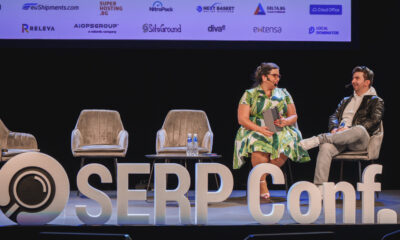
 SEARCHENGINES6 days ago
SEARCHENGINES6 days agoGoogle Needs Very Few Links To Rank Pages; Links Are Less Important
-

 SEO6 days ago
SEO6 days agoHow to Become an SEO Lead (10 Tips That Advanced My Career)
-

 MARKETING6 days ago
MARKETING6 days agoHow to Use AI For a More Effective Social Media Strategy, According to Ross Simmonds
-

 PPC6 days ago
PPC6 days agoBiggest Trends, Challenges, & Strategies for Success
-

 SEARCHENGINES4 days ago
SEARCHENGINES4 days agoGoogle Won’t Change The 301 Signals For Ranking & SEO
-

 SEARCHENGINES5 days ago
SEARCHENGINES5 days agoGoogle Again Says Ignore Link Spam Especially To 404 Pages
-

 SEO3 days ago
SEO3 days agobrightonSEO Live Blog






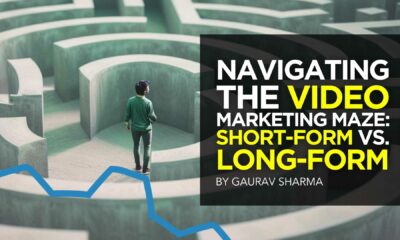





![The Current State of Google’s Search Generative Experience [What It Means for SEO in 2024] person typing on laptop with](https://articles.entireweb.com/wp-content/uploads/2024/04/The-Current-State-of-Googles-Search-Generative-Experience-What-It.webp-400x240.webp)
![The Current State of Google’s Search Generative Experience [What It Means for SEO in 2024] person typing on laptop with](https://articles.entireweb.com/wp-content/uploads/2024/04/The-Current-State-of-Googles-Search-Generative-Experience-What-It.webp-80x80.webp)

